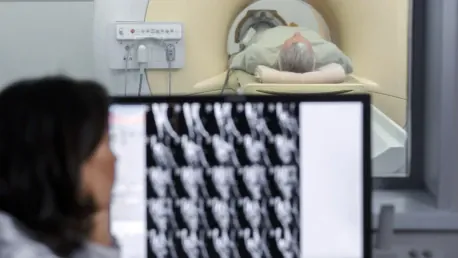The recent shortage of radioisotopes has sparked an outcry from medical professionals, who are warning about a looming public health crisis. Nuclear medicine is critical to the detection and treatment of various cancers, and hospitals around the UK are concerned about the pressure this will put on the National Health Scheme (NHS).
A plant in the Netherlands experienced a malfunction, which triggered the shortage of Molybdenum-99 (Mo-99), which is key to the production of Technetium-99 (Tc-99), the radioisotope used in medicine.
Unfortunately, thousands of patients in the UK rely on these treatments and countless others are left without diagnostic tools for early detection. Adding to the supply chain strain is the fact that the UK relies on other European countries to produce Mo-99.
WIth lives on the line, experts are advocating for a long-term solution to the supply of nuclear medicine, which exists in a fragile ecosystem, yet is critical to saving lives. Here’s how the various stakeholders have responded to the shortage:
Project Arthur: A Long-Term Solution to an Immediate-Term Crisis
Healthcare experts have voiced their concerns and issued warnings to the government in the wake of an inevitable public health crisis. The shortage of Tc-99 will leave thousands without treatment options while staring down the barrel of life-threatening and terminal illnesses.
Without the required radioisotope, hospitals and patients can expect major delays in diagnosis. This is particularly distressing considering that early detection is a critical life-saving intervention when treating cancer patients.
The long-term solution is for the UK to end its dependence on European countries with aging infrastructure; a fragile supply chain ecosystem upon which the lives of thousands depend on. To do so, the UK would have to invest in a medical laboratory, a solution which is currently under discussion. The proposal details that a nuclear medicine manufacturing plant would cost approximately £400 million, and researchers have already identified a site.
This plan is referred to as Project Arthur; a small-scale nuclear plant in Wales’ northern region, Trawsfynydd Gwynedd. This would allow the UK to manufacture the radioisotopes needed for healthcare and effectively manage the supply and distribution of Mo-99 and Tc-99 across hospitals and clinics in the NHS.
Experts Champion Project Arthur
Professor Simon Middleburgh weighed in on this precarious situation at Bangor University’s Nuclear Futures Institute, stating, “For every month that we don’t have a diagnosis, or a person doesn’t have a diagnosis, their chances of succumbing to cancer increase by 10 percent.” Worryingly, he added that this isn’t a future concern: “It is actually resulting in people dying from this now.”
Advocating for Project Arthur, Prof Middleburgh emphasizes the fact that the shortage of nuclear medicine is already fatal for thousands of people across the country. “These people are not getting the diagnosis, they are not getting those cancers caught early on, cancer will spread, people will die. It’s going to be hundreds if not thousands due to just this month’s shortage in isotopes this time around,” he explained.
Further strengthening his position, Prof Middleburgh points out that the project is certainly viable. Based on feasibility study results, the UK is well-positioned to generate the nuclear isotopes that patients need. It’s not just about addressing this particular malfunction in the Netherlands, but rather, about securing the healthcare needs of citizens by ensuring patients have a steady, reliable supply of medication while fighting life-threatening illnesses.
“The business case is there, it’s not new technology, it’s old technology – we can buy it off the shelf,” said Prof Middleburgh. “It’s not just a Wales thing – it’s an across the UK thing – we’re all ready to go, it is just time to press the green button and get on with it.”
Using Radioisotopes in Medicine
When healthcare practitioners refer to nuclear medicine, they are, more often than not, referring to Tc-99. Technetium is used in about 80% of all medical cases requiring nuclear medicine and is required for both diagnostics and treatment. As a treatment, patients either take the medication intravenously or orally, where the Gamma radiation (an example of one type of radiation) is absorbed by cancer cells.
The radiation is useful for ongoing monitoring, showing up in scans of cancer cells, and depicting their size and location.
While the use cases most commonly cited are cancer treatment and diagnosis, Tc-99m Sestamibi scans are used to diagnose coronary heart disease. Alternatives to this exist, for example in angiography, but nuclear imaging is the superior diagnostic tool, prioritizing patient comfort and convenience, medical accuracy, and ease.
No Quick Fixes: A Concern for Patients
For cancer patients, every day counts. The earlier they’re diagnosed, the better their chances for recovery and survival. The shortage of nuclear medicine will have a knock-on effect, creating backlogs, bottlenecks, and waitlists in an already overstrained healthcare system.
While Project Arthur proves to be a viable solution, it is a long-term one, and it will be years before patients ever see the benefits of the lab. While waiting on a decision to move forward, the Department of Health and Social Care continues to reassure patients that they’re working to find a solution in the short term.
“We know this may be concerning for patients and we are working closely with the company involved to resolve the issue,” said a UK government official. “We are also working in close partnership with NHS England and the devolved governments to distribute available stock and prioritize patients with critical needs.”
While the government is doing what it can to prioritize care, the outlook isn’t great. A triage system for cancer patients means that only critical patients will have access to nuclear medicine, where it is likely to be less effective, while those who could greatly benefit will have to wait until they, too, become critical. It’s a vicious cycle of managed care.
Over in Wales, however, the government is committed to pushing Project Arthur forward, collaborating with stakeholders and partners to bring the lab to life. “We will provide an update on progress in due course.”
Conclusion
The UK is facing a severe shortage of medical radioactive isotopes critical for diagnosing and monitoring cancers like breast and bowel cancer. This shortage, caused by a production halt at a Dutch reactor, has delayed essential diagnostic tests, increasing cancer mortality rates. Experts warn that delayed diagnoses raise the risk of death by 10% per month, potentially leading to hundreds or thousands of deaths.
Calls for a domestic isotope production facility have intensified to address this crisis. Project Arthur, a proposed initiative to build a small-scale nuclear reactor at Trawsfynydd, Wales, is a vital solution.
Supported by experts like Prof. Simon Middleburgh of Bangor University, the project aims to create a home-grown supply of isotopes, reducing reliance on imports. While the technology is readily available, construction delays mean the facility won’t be operational until 2030.
In the interim, the UK government and NHS redistribute limited isotope supplies to prioritize critical patients. However, political leaders and healthcare advocates stress the urgent need for immediate funding and commitment to prevent future crises and save lives. The Welsh government remains committed to the project, emphasizing the long-term benefits of a self-sufficient isotope supply chain.









